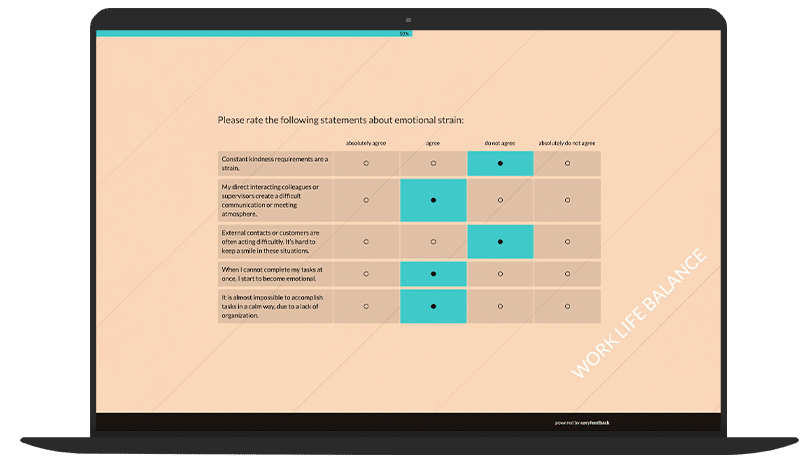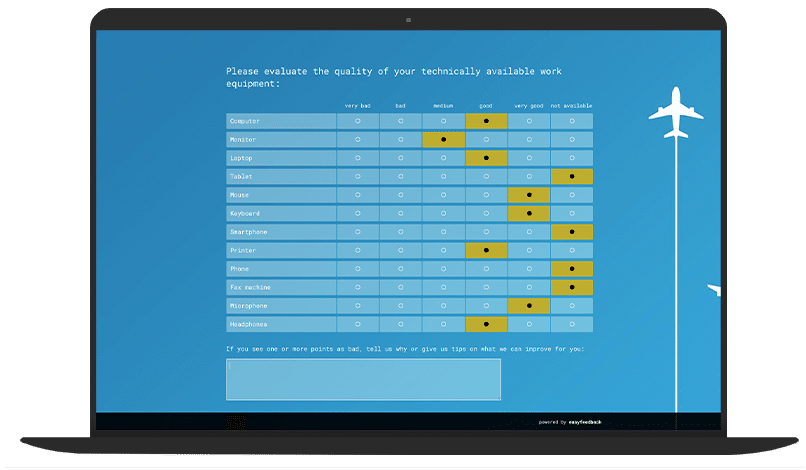What is the sickness rate?
In general, the sickness rate refers to the ratio of sick people to a specific population group or sample.
In HR, the term “sickness rate” is often used to express the ratio of the number of sick days taken by employees to the total number of available working days in a given period.

This metric is often used to assess employee health and wellbeing, quantify the cost of sickness absence and identify possible trends or patterns in sickness absence within an organization.
The sickness absence rate in HR is usually expressed as a percentage and can help to evaluate the effectiveness of measures to promote employee health and reduce sickness absence.
What is a normal sickness rate?
A “normal” sickness rate in companies varies greatly depending on the industry, company size, geographical location and other factors.
There is no universal definition or fixed figure for a ‘normal’ sickness rate, as it is highly dependent on the specific circumstances and conditions of each company.
In some industries, where working conditions are demanding or there is a higher risk of injury or illness, higher sickness rates may be considered acceptable.
In other industries that are less physically demanding or where comprehensive health and prevention measures are implemented, lower sickness rates may be targeted.
According to the German health insurance company DAK-Gesundheit , an average of 20 days per employee were absent from work in 2023 in Germany, as shown by its own data on insured persons. As a result, the sickness rate once again reached a record high of 5.5%, as it did in 2022.
What impact does a high sickness rate have on the company?
A high sickness rate can have a significant impact on a company.
On the one hand, it can affect productivity, as employees who are absent due to illness are unable to complete their work tasks.
This can lead to delays in projects and affect the efficiency of work processes.

It can also result in additional costs, be it through the payment of sick days, the hiring of replacement staff or the overtime for remaining employees who have to take over the work of their absent colleagues.
A high sickness rate can also lead to an increased workload for remaining staff, which in turn can cause stress and dissatisfaction.
This can affect employee morale and commitment as well as undermine trust in management.
In addition, high levels of sickness absence can affect the quality of customer service, which can negatively impact customer satisfaction and damage the company’s image and reputation in the long term.
Furthermore, a high sickness rate can disrupt operational processes and lead to bottlenecks in various departments or teams.
This can lead to inefficient processes and delays in projects.
Overall, a high sickness rate can have a significant impact on a company’s performance, finances and working atmosphere.
It is therefore important to take preventative measures to reduce sickness rates and promote a healthy working environment.
What are the reasons for a high sickness rate among employees?
There are a variety of reasons that can lead to a high sickness rate among employees.
Some of these reasons are:
1st reason: Workload
Excessive stress, long working hours and high work demands can affect physical and mental health and lead to illness.
This often occurs through the release of stress hormones. Chronic stress can lead to a decrease in the ability to concentrate, a deterioration in work performance and an increase in errors at work.

2nd reason: Working environment
Poor working conditions, inadequate ventilation, poor lighting or an uncomfortable temperature can increase the risk of illness.
An unfavorable work environment can lead to complaints such as headaches, eye strain, respiratory illnesses and other health problems that can further increase employee stress.

3rd reason: Lack of work-life balance
Employees who find it difficult to balance work and personal life may fall ill more often because they feel overworked and stressed.
This imbalance can make them feel permanently unwell, which can affect both their bodies and their minds.
People who feel they have no time for their personal needs and social relationships have a higher risk of burnout, anxiety, depression and other stress-related illnesses.
In addition, the lack of time for rest and relaxation can lead to worsening physical ailments such as muscle tension, sleep problems and digestive issues.
Chronic stress also weakens the immune system, increasing susceptibility to infection and illness.

4th reason: Lack of support and communication
Insufficient support from management, a lack of clear communication and a lack of teamwork can affect employee wellbeing and lead to increased sickness rates.
If employees feel that their concerns are not being heard or that they are not receiving enough support from their managers, this can lead to frustration and stress, which in turn can affect their health.

5th reason: Workplace health risks
Certain work environments can pose specific health risks, such as workplace hazards, exposure to harmful substances or ergonomic issues that can lead to injury or illness.
Workers in industries such as construction, healthcare or manufacturing may be at increased risk of work-related injury or illness.
6th reason: Lack of health promotion
Companies that do not offer programs to promote the health and well-being of their employees could have a higher sickness rate due to a lack of preventative measures.
What to do about high sickness rates?
Various measures can be taken to reduce a high sickness rate in a company.
Here are some suggestions:
1st action: Promote a healthy work environment
Ensure that working conditions are safe, ergonomic and health-promoting to promote employee productivity and well-being.
This can include providing ergonomic workstations designed to minimize physical strain and maximize efficiency.
Ergonomic furniture such as height-adjustable desks and ergonomic chairs can reduce back pain and improve posture.

Additionally, adequate ventilation in work areas is critical to maintain air quality and minimize the spread of illness.
This can be achieved through regular maintenance of heating, ventilation and air conditioning systems, as well as providing windows for natural airflow.
Good lighting is also essential to reduce eye strain and improve concentration.
Natural light is preferable, but if this is not possible, artificial lighting systems should be used that are glare-free and sufficiently bright to create a comfortable working environment.
In addition, adequate break opportunities are important to allow employees to rest and rejuvenate.
Taking short breaks during the working day can help to reduce mental and physical fatigue and increase productivity.
Companies can support this by providing break rooms, rest areas or even simply encouraging short walks outside.

2nd action: Health promotion programs
Implement programs to promote the health and well-being of employees to ensure holistic care.
These programs can include various offerings aimed at supporting the physical and mental health of employees.
Health checks are an important measure to identify potential health risks at an early stage and provide employees with targeted recommendations for their health care.

Regular medical examinations, blood pressure measurements, blood tests and other screenings can help to prevent illnesses or treat them at an early stage.
Fitness classes and exercise programs offer employees the opportunity to stay active and get physically fit.
This can range from group fitness classes to yoga or Pilates classes to special exercise programs tailored to employees’ needs.

Nutritional advice is another important component of a holistic health program.
Through individual counseling or group seminars, employees can receive information on healthy eating habits and learn how to improve their eating habits to promote their health.
Stress management courses are very important in today’s workplace, as stress can lead to a variety of health problems.
These courses can teach techniques such as meditation, breathing exercises, relaxation techniques and time management strategies to help employees deal with stressful situations and find a work-life balance.
Smoking cessation programs are especially important to help employees quit smoking and improve their health.
These programs can provide nicotine cessation support, including behavioral counseling, medication support and peer support groups.
By implementing these programs, you as a company can promote a culture of health and wellness and provide your employees with the resources they need to lead healthy and fulfilling work lives.
3rd action: Flexibility in work organization
Offer flexible working models to give employees more freedom and autonomy in their work organization.
By providing part-time options, employees have the opportunity to adapt their working hours to their individual needs.
This can be particularly beneficial for parents, carers or employees who have additional commitments outside of work.
Home office options are another important flexibility measure that allows employees to work from home.
Not only does this offer an improved work-life balance, but it can also reduce stress and commuting time.
By utilizing modern technologies such as video conferencing and cloud-based work platforms, employees can also collaborate effectively remotely.
Flexible working hours give employees the freedom to adjust their working hours according to their personal preferences.
This can mean that employees can start and finish earlier or later depending on their individual preferences and commitments outside of work.
By working flexible hours, employees can increase their productivity by working at times when they are most productive while better meeting their personal commitments.
4th action: Clear communication and support from management
Make sure you have clear expectations and goals and that management supports you and stands by your side when needed.
This includes not only setting clear work tasks and goals, but also creating a supportive environment in which you feel empowered to achieve these goals.
Transparent management that is open to your questions and concerns is crucial to building trust and fostering a positive work environment.
Open communication is a cornerstone of a healthy work environment. You should feel encouraged to freely express your thoughts, concerns and ideas without fear of negative consequences.
Regular feedback sessions between you and your managers are important to evaluate your performance, identify development needs and recognize successes.
This not only strengthens your bond with the company, but also promotes your continuous improvement and personal development.
In addition, it is important to give you the opportunity to raise concerns and address issues that may affect your well-being.
A sympathetic ear from management and appropriate conflict resolution mechanisms can help to identify and resolve potential issues early on before they develop into major challenges.
5th action: Workplace culture and teamwork
Promote a positive workplace culture that emphasizes teamwork, collaboration and mutual support.
A supportive environment can help reduce stress and improve the overall well-being of employees.
By creating a climate where teamwork and collaboration are valued, employees can support each other, share ideas and work together to find solutions.

Your company should take active steps to foster a culture of appreciation and recognition.
This can be done through regular praise, employee awards or special recognition programs.
When employees feel valued and the impact of their work is recognized, not only does their motivation increase, but so does their overall wellbeing.
An open and inclusive workplace culture that respects diversity and difference can also help to improve employee wellbeing.
By creating an environment as a company where every employee is heard and valued, all employees can develop authentically and reach their full potential.
Targeted team-building activities and events outside the workplace can strengthen relationships and promote a sense of belonging.
This helps to expand employees’ social support network and strengthen their mental health.

6th action: Promote health awareness
Provide training and programs to raise awareness of health issues and encourage employees to actively take care of their health and take preventive measures.
Through targeted training, employees can be informed about various aspects of health, including physical health, mental well-being and stress management.

Such training can cover topics such as healthy eating, regular exercise, sleep hygiene, stress management techniques and the importance of work-life balance.
By giving employees the knowledge they need, they can make informed decisions about their health and promote positive behaviors.
In addition to education, wellness programs can also be implemented to encourage employees to stay active and maintain healthy habits. This can include organizing group activities such as running groups, yoga classes or meditation sessions.
Such programs not only promote physical health, but can also strengthen the sense of community and promote team spirit.
Furthermore, health days or health fairs can be organized to give employees access to various healthcare providers and resources.
This gives them the opportunity to review their health, learn about preventative measures and engage for further support if needed.
How is the sickness rate calculated?
The sickness rate is usually calculated as a percentage and indicates how many employees of a company were reported sick during a certain period.
The formula for calculating the sickness rate is as follows:

To determine the average number of employees, the number of employees at the beginning and end of the period under consideration are normally added together and divided by two.
Example: If a company had 200 employees at the beginning of the month and 220 employees at the end of the month, the average number of employees is (200 + 220) / 2 = 210 employees. Assume that 10 employees were reported sick during this month.
The sickness rate would then be calculated as follows:

This means that the company’s sickness rate for that month is approximately 4.76 %.
How can a survey tool like easyfeedback help with sickness rates?
A survey tool such as easyfeedback can help to analyze the sickness rate in a company and identify potential causes of sickness absence.
By creating and conducting employee surveys, companies can gain insight into the reasons for frequent sickness absence, whether due to workload, work environment, stress factors or other health-related challenges.
With easyfeedback, companies can create customized surveys that cover specific aspects of employee health and wellbeing.
These surveys can be conducted anonymously, allowing employees to give honest and open answers without worrying about possible consequences.
By analyzing the survey results, companies can identify patterns and trends associated with increased sickness absence.
In addition, easyfeedback enables companies to receive feedback from employees on how they can improve their working conditions to promote employee health and wellbeing.
This could include introducing health promotion programs, implementing flexible working hours or improving communication and management support.
By using easyfeedback or similar survey tools, companies can proactively respond to the challenges associated with sickness absence and take targeted measures to improve the health and well-being of their employees.
In the long term, this can help to reduce sickness rates and increase the company’s performance and productivity.
Conclusion: Reduce the sickness rate for higher productivity
We are nearing the end of my article.
I hope I have been able to give you a deep insight into the importance of sickness rates as a metric for employee retention and wellbeing.
Before we conclude, however, I would like to emphasize that the sickness rate is much more than just a statistical measure. Rather, it acts as an important indicator of how well a company is looking after its employees.
A low sickness rate typically indicates a positive working environment and signals strong employee loyalty to the company.
In contrast, a high rate can indicate potential problems with employee retention or the working environment.
By using the sickness rate as an indicator and implementing appropriate measures to improve working conditions and employee wellbeing, companies can not only promote the health and satisfaction of their employees, but also strengthen their productivity and competitiveness in the long term.
It is therefore crucial to regularly monitor the sickness rate and respond proactively.
This is the only way to create a positive work culture that ensures the long-term success of the company.
More on the topic of employee retention
- Why employee retention is more important than ever
- 6 pillars of employee retention
- 6 methods to measure employee retention
- 8 measures to increase employee retention
- 5 Methods for measuring the employee experience
- Employee Net Promotor Score (eNPS): measuring employee loyalty
- The turnover rate: a key figure for measuring employee retention
- How surveys can help reduce employee turnover!
- 6 KPIs and metrics for measuring employee retention







